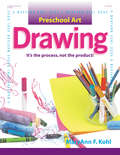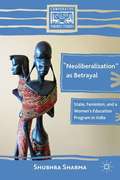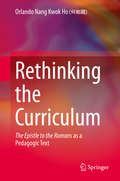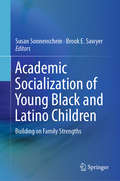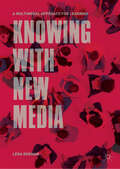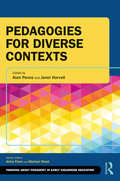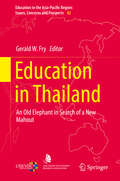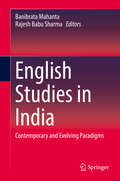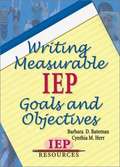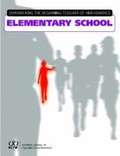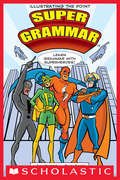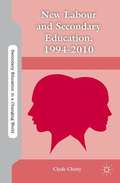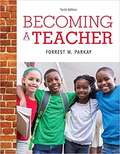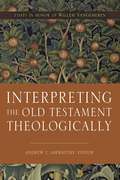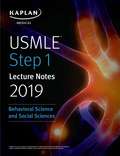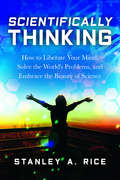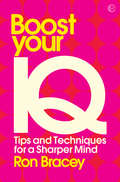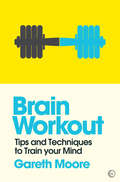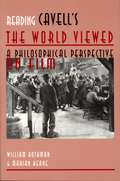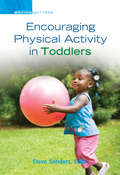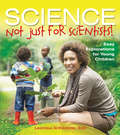- Table View
- List View
Preschool Art: Drawing
by MaryAnn F. KohlExplore and create with chalk, crayons, stencils, textures, and more! Encourage children to experience the joy of exploration and discovery with this view series by MaryAnn Kohl. Excerpted from the national best-seller Preschool Art, each book in the series emphasizes the process of are, not the product. Make art fun and accessible to children of all ages with these creative, easy-to-do activities! - See more at: https://www.gryphonhouse.com/books/details/preschool-art-drawing#sthash.6HK3Q5Pw.dpuf
"Neoliberalization" as Betrayal: State, Feminism, and a Women’s Education Program in India (Comparative Feminist Studies)
by Shubhra SharmaThis book is concerned with the three-way relationship between neoliberalism, women's education, and the spatialization of the state, and analyses this through an ethnography lens of women's education programs in India.
Rethinking the Curriculum: The Epistle to the Romans as a Pedagogic Text
by Orlando Nang Kwok Ho<p>This book is an inter-disciplinary endeavour. Encompassing education and basic research, it discusses the modular-curriculum embodied in The Epistle from educational, historical, sociolinguistic, anthropological, phenomenological, and non-sectarian perspectives. It shows the cross-boundary philosophical reasoning and pedagogic dimensions of St. Paul as a great teacher and thinker from the Jewish-and-Christian faith. In doing so, this book refocuses academia’s attention on the inevitable antimonic nature inherent in humans’ efforts to create systemic knowledge. Knowledge about the inner aesthetic and volitional-interpretative self – the immanent psychic “I” – and other philosophical aspects of the realm of the transcendental should be rescued from the deepening trends of secularity. Being strong, powerful, productive, and performative should not be taken as the indisputable and exclusive aim of education. Science, Technology, Engineering, and Mathematics (STEM) do not constitute a sufficient basis for building a better humanity. Education via public curriculums ought to serve both the belly and the mind. Deliberative curricular recalibrations, with rationales for grace, are thus needed for a better future for humanity.... <p>This book is relevant for anyone with a core fascination about truths, values, epistemologies, life, spirituality, and holistic human development. It can also be used as a textbook or a reference in a number of fields including counselling, psychology, translation, cultural studies, and theology.</p>
Academic Socialization of Young Black and Latino Children: Building on Family Strengths
by Susan Sonnenschein Brook E. SawyerThis book offers a strengths-based, family-focused approach to improving the educational performance and school experience of struggling Black and Latino students. The book discusses educational challenges faced by low-income families of color and the different strengths within Black and Latino family life that can affect these challenges. It focuses building on these strengths within the children’s home environments that can serve as a foundation for subsequent learning. The chapters describe a wide range of family practices and beliefs, including development of interventions to support families that promote early language and literacy, early mathematics, and social skills. The chapters also present quantitative and/or qualitative studies using a strengths-based approach to parents’ socialization of their children’s early academic skills.
Knowing with New Media: A Multimodal Approach for Learning
by Lena RedmanThis cutting edge book considers how advances in technologies and new media have transformed our perception of education, and focuses on the impact of the privatisation of digital tools as a mean of knowledge production. Arguing that education needs to adapt to the modern learner, the book’s unique approach is based on a disassociation with the deeply ingrained attitude with which people have traditionally viewed education – learning the existing symbolic systems of certain disciplines and then expressing themselves strictly within the operational modes of these systems. The ways of knowledge production – exploring, recording, representing, making meaning of and sharing human experiences – have been fundamentally transformed through the infusion of digital technologies into all aspects of human activity, allowing learners to engage with their immediate natural, social and cultural environments by capitalising on their individual abilities and interests. This book proposes a new approach to teaching and learning termed ‘cinematic bricolage’, which involves generating knowledge from heterogeneous resources in a ‘do-it-yourself’ manner while making meaning through multimodal representations. It shows how cinematic bricolage reconnects ways of knowing with ways of being, empowering the individual with a sense of personal identity and responsibility, helping to shape more aware social citizens.
Pedagogies for Diverse Contexts (Thinking About Pedagogy in Early Childhood Education)
by Alan Pence Janet HarvellDiversity can be a rich source of possibility and opportunity in early childhood education. Appreciating that learning and development are shaped by culture and context, history and values, the diversity of cases found in this volume provide a useful tension in considering one’s own practices, policies and beliefs. Pedagogies for Diverse Contexts draws on the knowledge and professional experiences of actors from a wide range of countries and cultures. For some, early childhood’s dominant narratives have been influential, while others push back against universalistic orientations and the power of a neoliberal hegemonic agenda. Written to provoke, to stimulate and to extend thinking, these chapters provide insights and examples relevant not only for front-line practice and programme development, but for education, assessment, research and policy development. The twelve chapters are divided into four key sections which reflect major influences on practice and pedagogy: Being alongside children Those who educate Embedding families and communities Working with systems Considering varied international practices, this key text will enhance understanding, support self-directed learning, and provoke thinking at both graduate and postgraduate levels, particularly in the field of early childhood education and care.
Education in Thailand: An Old Elephant In Search Of A New Mahout (Education in the Asia-Pacific Region: Issues, Concerns and Prospects #42)
by Gerald W. FryThis interdisciplinary book offers a critical analysis of Thai education and its evolution, providing diverse perspectives and theoretical frameworks. In the past five decades Thailand has seen impressive economic success and it is now a middle-income country that provides development assistance to poorer countries. However, educational and social development have lagged considerably behind itsglobally recognized economic success. This comprehensive book covers each level of education, such as higher and vocational/technical education, and such topics as internationalization, inequalities and disparities, alternative education, non-formal and informal education, multilingual education, educational policy and planning, and educational assessment. The 25 Thai and 8 international contributors to the volume include well-known academics and practitioners. Thai education involves numerous paradoxes, which are identified and explained. While Thailand has impressively expanded its educational system quantitatively with much massification, quality problems persist at all levels. As such, the final policy-oriented summary chapter suggests strategies to enable Thailand to escape “the middle income trap” and enhance the quality of its education to ensure its long-term developmental success.
English Studies in India: Contemporary And Evolving Paradigms
by Banibrata Mahanta Rajesh Babu SharmaThis volume is a collection of scholarly papers that explore the complex issues concerning English Studies in the present Indian context. The discussions in this volume range from historical perspectives to classroom-specific pedagogies, from sociological and political hierarchies to the dynamics of intellectual development in the English language environment. Interrogating both policy and practice pertaining to English Studies in the context of Indian society, culture, history, literature and governance, the chapters seek to formulate contemporary perspectives to these debates and envision alternative possibilities. Since the introduction of English to India more than 2 centuries ago, the language has transmuted the very fabric of Indian society, culture, history, literature and governance. The idea of India cannot be conceived in its entirety without taking into consideration the epistemological role that English has played in its formation. The present globalized world order has added dimensions to English Studies which are radically different from those of India’s colonial and postcolonial past. It is therefore imperative that the multitudinous shades and shadows of the discipline be re-examined with inputs drawn from the present context. This volume is for scholars and researchers of English literature and language studies, linguistics, and culture studies, and others interested in exploring new paradigms of engagement with the disciplinary formulation of English Studies in India.
Writing Measurable IEP Goals and Objectives
by Barbara D. Bateman Cynthia M. HerrA guide to quick and effective writing of accurate and measurable IEP goals and objectives. IEPs are necessary, required by law and when done properly can be extremely helpful in guiding the student's educational trajectory. This book, written by two of the foremost special educators and IEP legal experts is designed to bring you up to speed whether you're just entering the field or have worked in it for years.
Empowering The Beginning Teacher Of Mathematics In Elementary School
by Michaele F. Chappell Jane F. Schielack Sharon Zagorski Jane SchielackThose beginning their journeys as teachers of mathematics will encounter challenges both inside and outside the classroom. These volumes have been compiled to help new teachers reach their full potential as mathematics educators, thereby improving the mathematics learning of their students. The resources in these books highlight six broad categories: professional growth, curriculum and instruction, classroom-level assessment, classroom management and organisation, equity and school and community. <p><p> The ideas and advice from experienced educators are designed to help beginning elementary school teachers maintain their students' natural interest in, and enthusiasm for, mathematics by nurturing rich mathematical thinking through talking, experimenting and sharing ideas. The book addresses classroom management issues, questioning skills, professional growth and more.
The Internationalization of East Asian Higher Education: Globalization’s Impact (International and Development Education)
by John D. Palmer Amy Roberts Young Ha Cho Gregory S. ChingDevelops new and intriguing insights into globalization theory and internationalization practice, expanding the investigation of East Asian values and contexts in comparison and separate from Western-dominant thoughts of globalization and internationalization in higher education.
Super Grammar
by Rhode Montijo Tony PreciadoThink grammar is difficult? You just need someone to save you from it! The best learning tools for a young mind are word association, visual aids, and superpowers! In SUPER GRAMMAR, all of the major elements of grammar will be personified with superhero or super villain identities. You won't just learn about the part-of-speech called an adverb. Instead you'll meet the vibrant super heroine The Adverb, and you'll learn about her awesome ability to modify verbs and other adverbs. You won't simply be told that you shouldn't use a double negative in a sentence. Instead you'll actually meet the sinister twin brothers, Double Negative, and you'll learn how to avoid being tricked into falling for their double talk. The book's fun, full-color design looks like a mix between a reference book and a comic book. With SUPER GRAMMAR you'll learn to save yourself!
New Labour and Secondary Education, 1994–2010 (Secondary Education in a Changing World)
by Clyde ChittyNew Labour and Secondary Education, 1994-2010 assesses New Labour's policy towards secondary education in Britain. It shows that, in many respects, New Labour education policy was a continuation of the policies pursued by the education ministers of Margaret Thatcher and John Major.
Becoming a Teacher
by Forrest W. ParkayExperts and novices shape a journey through foundational content toward professionalism. With a bright and engaging writing style that enlists the voices from experts as well as novices, Becoming a Teacher explores what it means to be a professional teacher in today’s climate of accountability, high-stakes testing, and changing legislation. <P><P>Fully revised, the Tenth Edition explores the changing field of education, outlining ways to be an agent of change in the profession, pinpointing meaningful uses of technology in education, clarifying realities of school and classroom diversity, and clearly outlining past, present, and future thoughts on curriculum, instruction, management, philosophy, and issues in education. This straightforward approach provides students with the tools and information necessary to answer the questions, “What does it take to become a high quality teacher?” and “Do I want to teach?” Along the way, the author provides practical perspectives for meeting the challenges of teaching. Organized into four parts, the book addresses both functional and foundational topics to give readers a well-rounded view of the teaching profession. The Enhanced Pearson eText features embedded video, assessments, and audio clips.
Interpreting the Old Testament Theologically: Essays in Honor of Willem A. VanGemeren
by Andrew T. AbernethyHow should Christians read the Old Testament today? Answers to this question gravitate between two poles. On the one hand, some pay little attention to the gap between the Old Testament and today, reading the Old Testament like a devotional allegory that points the Christian directly to Jesus. On the other hand, there are folks who prioritize an Old Testament passage’s original context to such an extent that it is by no means clear if and how a given Old Testament text might bear witness to Christ and address the church.This volume is a tribute to Willem A. VanGemeren, an ecclesial scholar who operated amidst the tension between understanding texts in their original context and their theological witness to Christ and the church. The contributors in this volume share a conviction that Christians must read the Old Testament with a theological concern for how it bears witness to Christ and nourishes the church, while not undermining the basic principles of exegesis.Two questions drive these essays as they address the topic of reading the Old Testament theologically.Christology. If the Old Testament bears witness to Christ, how do we move from an Old Testament text, theme, or book to Christ?Ecclesiology. If the Old Testament is meant to nourish the church, how do scriptures originally given to Israel address the church today?The volume unfolds by first considering exegetical habits that are essential for interpreting the Old Testament theologically. Then several essays wrestle with how topics from select Old Testament books can be read theologically. Finally, it concludes by addressing several communal matters that arise when reading the Old Testament theologically.
USMLE Step 1 Lecture Notes 2019: Behavioral Science and Social Sciences (Kaplan Test Prep)
by Kaplan MedicalThe only official Kaplan Lecture Notes for USMLE Step 1 cover the comprehensive information you need to ace the exam and match into the residency of your choice.Up-to-date: Updated annually by Kaplan’s all-star facultyIntegrated: Packed with clinical correlations and bridges between disciplinesLearner-efficient: Organized in outline format with high-yield summary boxesTrusted: Used by thousands of students each year to succeed on USMLE Step 1Looking for more prep? Our USMLE Step 1 Lecture Notes 2019: 7-Book Set has this book, plus the rest of the 7-book series.
Scientifically Thinking: How to Liberate Your Mind, Solve the World's Problems, and Embrace the Beauty of Science
by Stanley A. RiceShows the many advantages of thinking like a scientist and argues that today's problems require a scientific approach.You don't have to be a scientist to think like a scientist. Anyone can do it and everyone should. This book will show you how. The advantages are many: from detecting bias to avoiding error and appreciating the richness of the world. Author Stanley Rice, himself a scientist, explains that science is essentially organized common sense. While the brain is hardwired for common sense, unfortunately, it also relies on a number of misleading tendencies. Instead of reasoning objectively it tends to rationalize. Often it sees what it wants to see rather than what is really there. And it is adept at both self-deception and deceiving others. Rice notes that these tendencies were useful in the past as the human race evolved in an often-hostile environment. But today bias and delusions put us at risk of worldwide catastrophe.The author invites readers to participate in the adventure of scientific discovery. He provides many interesting and humorous examples of how science works. He shows how hypothesis testing can be used to tackle everyday problems like car trouble or seeing through the specious appeal of a fad diet. Beyond practical applications, science meets the basic human need to satisfy curiosity: it tells verifiable stories about the universe, providing humans with fascinating narratives supported by testable facts. The author also explores some of science's biggest ideas, including natural selection (creating order out of randomness) and interconnectedness (Earth's systems are intricately intertwined). Read this book and learn to think like a scientist. It will guard you against being manipulated by politicians, corporations, and religious leaders, and equip you to deal with the world's most pressing problems. And you will have a lot of fun doing it.
Boost your IQ: Tips and Techniques for a Sharper Mind (Mindzone Ser. #3)
by Ron BraceyExpand your mind power with this easy to follow guide to improving your IQWould you love a higher intelligence rating? Would you like to work your mind to its limits? This book will help you with these aims as well as enhance your reasoning powers and increase your ability to absorb and analyze information. With a range of enjoyable and engaging exercises you’ll soon be boosting your brain to peak e!ciency, and you’ll also discover that achieving this goal will bring advantages in all aspects of life – from working out your finances or helping your child with their homework to solving a tricky problem at work or excelling at card or board games. Ron Bracey provides a wealth of techniques for maximizing your IQ, as well as teaching a range of skills to that go beyond IQ, such as using knowledge trees, intelligent mindfulness, timeframe thinking and emotional intelligence. Your mind is there to be used: follow this unique “IQ and smart thinking program” to take it up to its full capacity.
Brain Workout: Tips and Techniques to Train your Mind
by Gareth MooreUse it or lose it! Your mind needs exercise to stay in top condition, just as your body does. By working up a cerebral sweat in this ‘mental gymnasium’ you will soon have a lean, mean thinking machine on your shoulders.Your mind is what makes you tick, so keeping it in tip-top condition is as important as taking care of your body. By performing mental workouts you can build your brain power and keep your mind alert and agile well into old age. Brain Workout offers a mental gymnasium to keep your brain in trim. Here are dozens of tips for building up your mental muscles, as well as a program of exercises from gentle limbering-up to more complex challenges.Learn to hone your logical reasoning, number and word skills, pattern recognition, short- and long-term memory, comprehension, creative thinking, problem-solving, and much else besides. The exercises are fun to do and carefully devised to ensure you make progress across the whole spectrum of abilities. Self-testing enables you to assess your performance – you can learn as much from being wrong as from being right! Working systematically through the book, in no time you’ll be boosting your brain to peak efficiency. Get up to speed with Brain Workout. Stretch yourself to new limits. Give yourself the chance to excel.
A History of Wayne State University in Photographs, Second Edition
by M. Roy Wilson Evelyn AschenbrennerWayne State University traces its earliest roots to the Civil War era and Detroit's Harper Hospital, where its Medical College was founded in 1868. In 1917, a junior college was formed in the building now called Old Main and along with four other schools—education, engineering, pharmacy, and a graduate school—these units would come to be called Wayne State University (WSU). The second edition of A History of Wayne State University in Photographs traces the evolution of those early schools into a modern research university with an extensive urban campus. Following the first edition, author Evelyn Aschenbrenner uses historical photos and archival material to give readers a complete visual guide to Wayne State University’s development, including an update of the last ten years—just in time for WSU’s 150th anniversary. She charts official milestones of the university, including the organization of colleges into a university in the 1930s, the drive for state support in the 1950s, and the new buildings constructed as academic programs expanded. Aschenbrenner also surveys campus life, including disciplinary and curricular development, student life, and the university’s relations with its surrounding neighborhood, which were strained by various urban renewal programs. The second edition retains the thoughtful introduction by Charles K. Hyde and original foreword by Bill McGraw, who was a student at WSU in the late 1960s and early 1970s. In a new foreword, President M. Roy Wilson argues that anniversaries like our sesquicentennial are special because "they give us something that is hard to get during the normal work week: perspective." The second edition of A History of Wayne State University in Photographs compiles rare and intriguing images that will be make a perfect keepsake for current and former students, faculty and staff, and anyone interested in Detroit history.
Chaudhary Group: Rebuilding Nepal
by Christopher J. Malloy Lauren H. Cohen Inakshi SobtiProfessors Christopher J. Malloy and Lauren H. Cohen and Associate Director Inakshi Sobti (India Research Center) prepared this case. It was reviewed and approved before publication by a company designate. Funding for the development of this case was provided by Harvard Business School and not by the company. HBS cases are developed solely as the basis for class discussion. Cases are not intended to serve as endorsements, sources of primary data, or illustrations of effective or ineffective management.
Chaudhary Group: Rebuilding Nepal (B)
by Christopher J. Malloy Lauren H. Cohen Inakshi SobtiProfessors Christopher J. Malloy and Lauren H. Cohen and Associate Director Inakshi Sobti (India Research Center) prepared this case. It was reviewed and approved before publication by a company designate. Funding for the development of this case was provided by Harvard Business School and not by the company. HBS cases are developed solely as the basis for class discussion. Cases are not intended to serve as endorsements, sources of primary data, or illustrations of effective or ineffective management.
Reading Cavell's The World Viewed: A Philosophical Perspective on Film
by Marian Keane William RothmanIn their thoughtful study of one of Stanley Cavell's greatest yet most neglected books, William Rothman and Marian Keane address this eminent philosopher's many readers, from a variety of disciplines, who have neither understood why he has given film so much attention, nor grasped the place of The World Viewed within the totality of his writings about film. Rothman and Keane also reintroduce The World Viewed to the field of film studies. When the new field entered universities in the late 1960s, it predicated its legitimacy on the conviction that the medium's artistic achievements called for serious criticism and on the corollary conviction that no existing field was capable of the criticism filmed called for. The study of film needed to found itself, intellectually, upon a philosophical investigation of the conditions of the medium and art of film. Such was the challenge The World Viewed took upon itself. However, film studies opted to embrace theory as a higher authority than our experiences of movies, divorcing itself from the philosophical perspective of self-reflection apart from which, The World Viewed teaches, we cannot know what movies mean, or what they are. Rotham and Keane now argue that the poststructuralist theories that dominated film studies for a quarter of a century no longer compel conviction, Cavell's brilliant and beautiful book can provide a sense of liberation to a field that has forsaken its original calling. read in a way that acknowledges its philosophical achievement, The World Viewed can show the field a way to move forward by rediscovering its passion for the art of film. Reading Cavell's The World Viewed will prove invaluable to scholars and students of film and philosophy, and to those in other fields, such as literary studies and American studies, who have found Cavell's work provocative and fruitful.
Encouraging Physical Activity in Toddlers
by Steve SandersToddlers are on the move almost constantly! Even though encouraging physical activity is not a problem, you can model new movements and skills and lay the foundation for them to enjoy physical activity as they grow. Toddlers need lots of time to master the basics, such as jumping, rolling, and balancing. As they become more comfortable with their bodies and confident in their ability to be physically active, their desire to participate will increase. They’ll enjoy kicking and throwing different types of balls, walking up and down stairs, running outside, and pedaling tricycles. Most of their physical activity involves unstructured play, and rightly so. However, you can also introduce them to new equipment with structured play and then let them explore on their own or with playmates. If you help toddlers understand how to develop physical skills, you will help them build confidence and have fun being active. What a gift for a lifetime!
Science Not Just for Scientists: Easy Explorations or Young Children
by Carole H. Dibble Kathy LeeWith quick and simple ideas, 101 Easy, Wacky, Crazy Activities is guaranteed to enliven any day. Try Tongue Painting (yes, Tongue Painting!) or Squishy Squeezy (a clean and messy activity!) and open the door to creative discovery. Encourage children to think creatively, problem solve, and have fun while learning. Written by two experienced teachers, this collection of open-ended ideas is a book teachers and parents will want to keep handy. -
